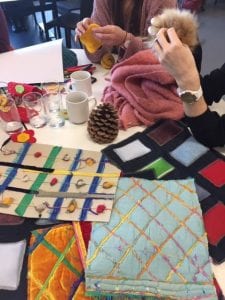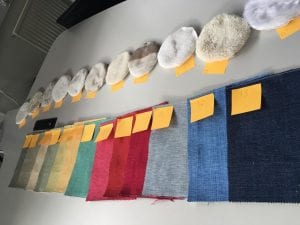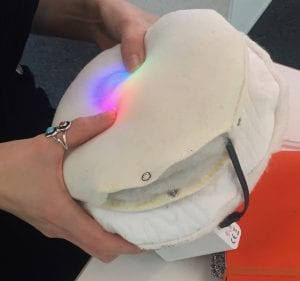Anxiety is one of the most prevalent mental health disorders at universities, with the pressure of exams, new environments and peer competition a major concern for student well-being. Using our combined expertise in soft robotic engineering, psychology and E-Textiles, we are aiming to design an object that can help relieve anxiety in students. We wanted to start our project extremely broad and so decided to run a series of ‘Unfocussed Groups’ to see how a large variety of objects, colours, textures and interactive technologies elicited different emotions and feelings in students. The task was extremely simple with students being asked to play with a set of objects at three different tables and tell us absolutely anything that sprung to mind during their interactions.
Students were presented with a range of colours and textures and there was a huge variety in responses. Most students described neutral colours as ‘boring’ and pastel colours seemed to be the winner in terms of having a ‘calming’ influence. When it came to textures, there was a resounding dislike towards scratchy, coarse material and lots of praise for fluffy and soft textures that were commonly described as ‘feeling like an animal.’ The favoured table was without doubt the ‘childhood toys’ table which included things such as water snakes and fidget spinners. Many students recalled fond memories of using pocket money on school trips to buy such items, with the triggering of such memories appearing to have a somewhat calming effect. Everyone seemed to enjoy the interactive component of these toys, with many people gravitating towards their favourite and then fidgeting with it for the remainder of the session. On the final table, students were given their first taste of tactile textiles which had been developed by the engineers. Different tech were embedded into identical cushions. Some cushions were designed to imitate breathing, one aimed to reflect a heartbeat and others consisted of subtle vibrations. Other cushions incorporated an interactive component, with coloured lights and sounds changing in response to one’s interaction. The moving cushions gained different responses with some people finding breathing and heartbeat sensations ‘relaxing’ and others describing them as quite ‘creepy’. All the students enjoyed playing with the coloured cushion and described it as ‘hypnotic’ and ‘calming’ but others still wanted more interaction such as the ability to stop or change the movement of colours.
Having collected a huge amount of information on students’ responses to various textiles and objects, the soft robotic engineers are now developing our first prototype: The Calming Cushion.



